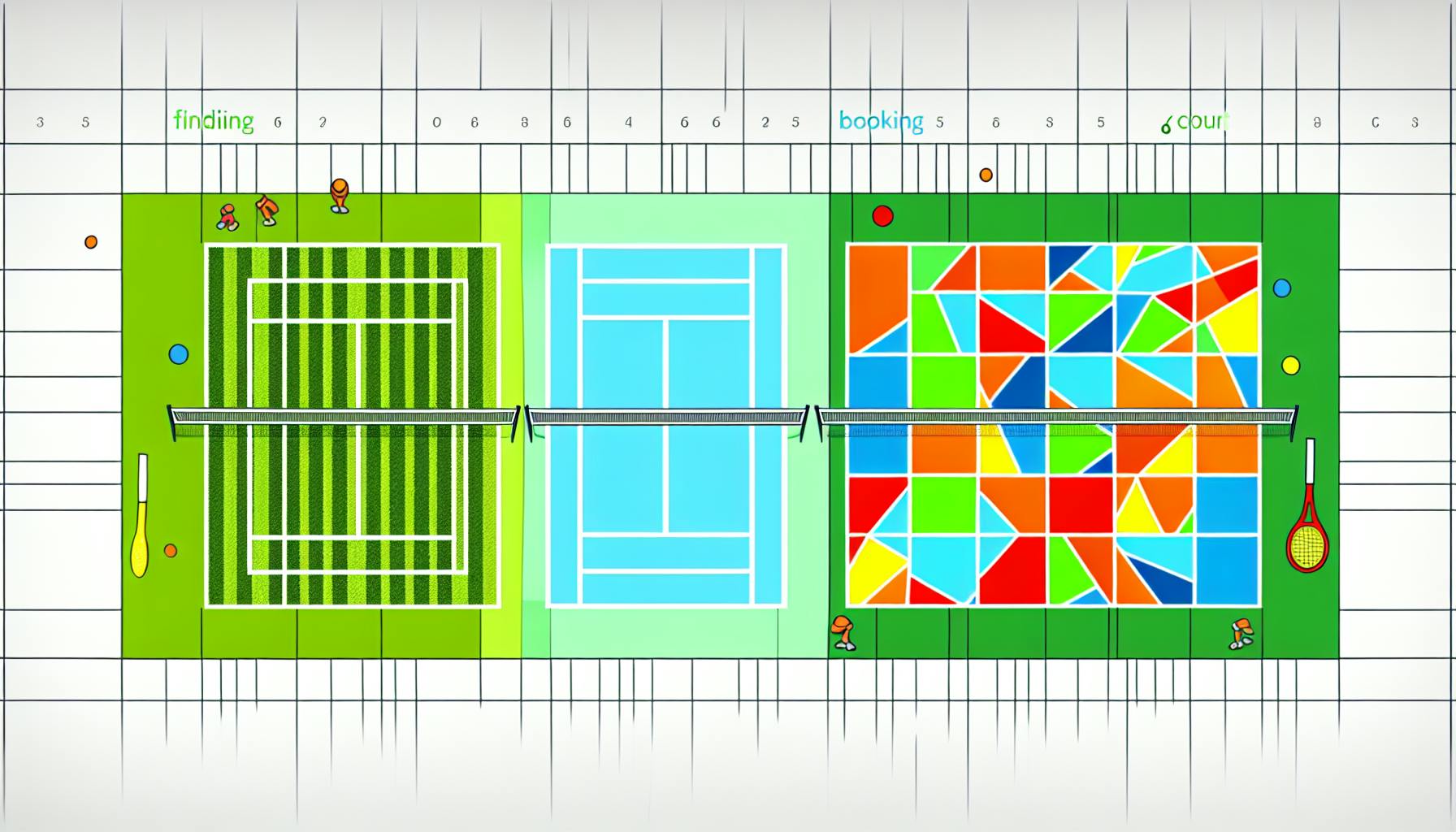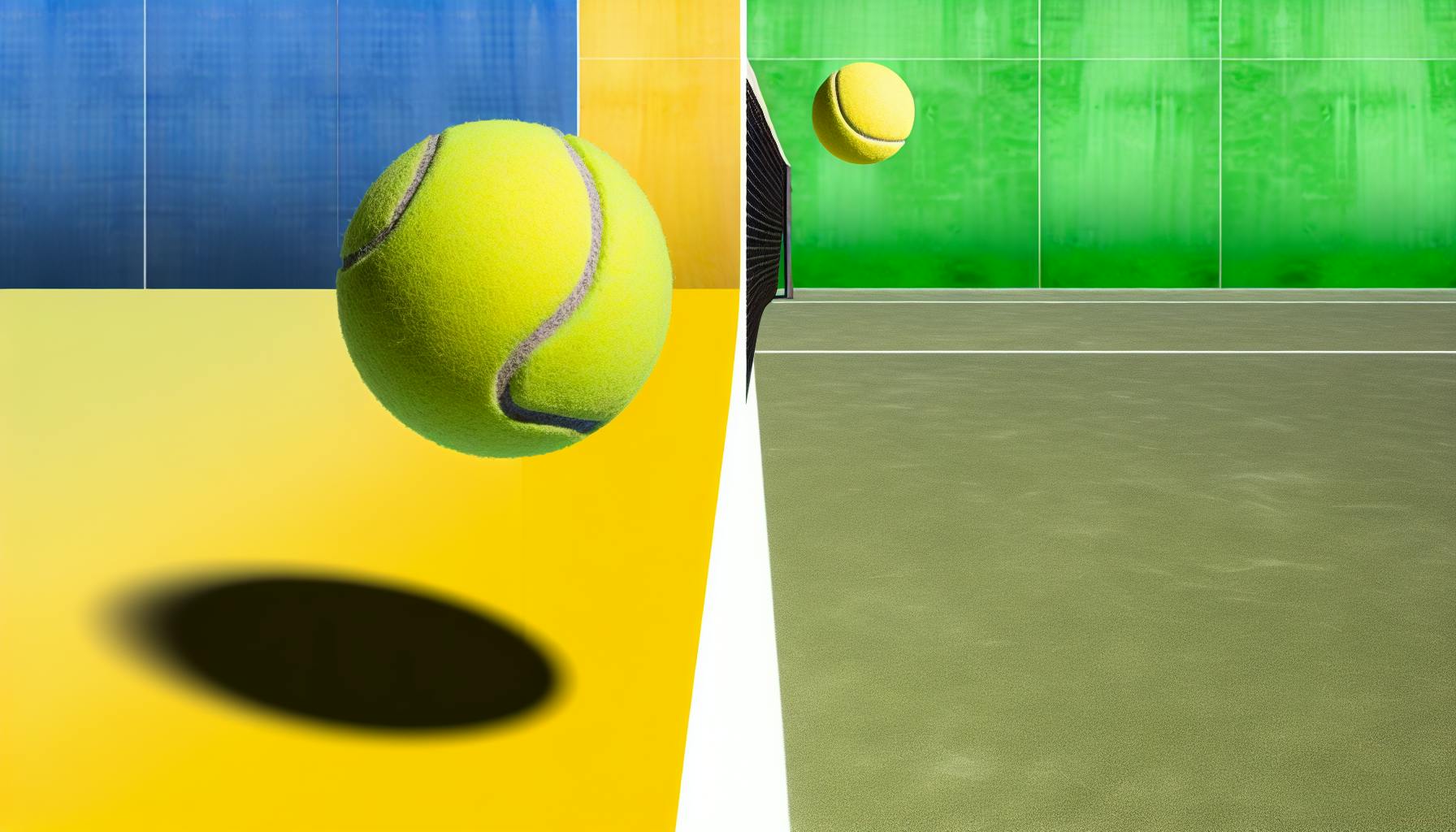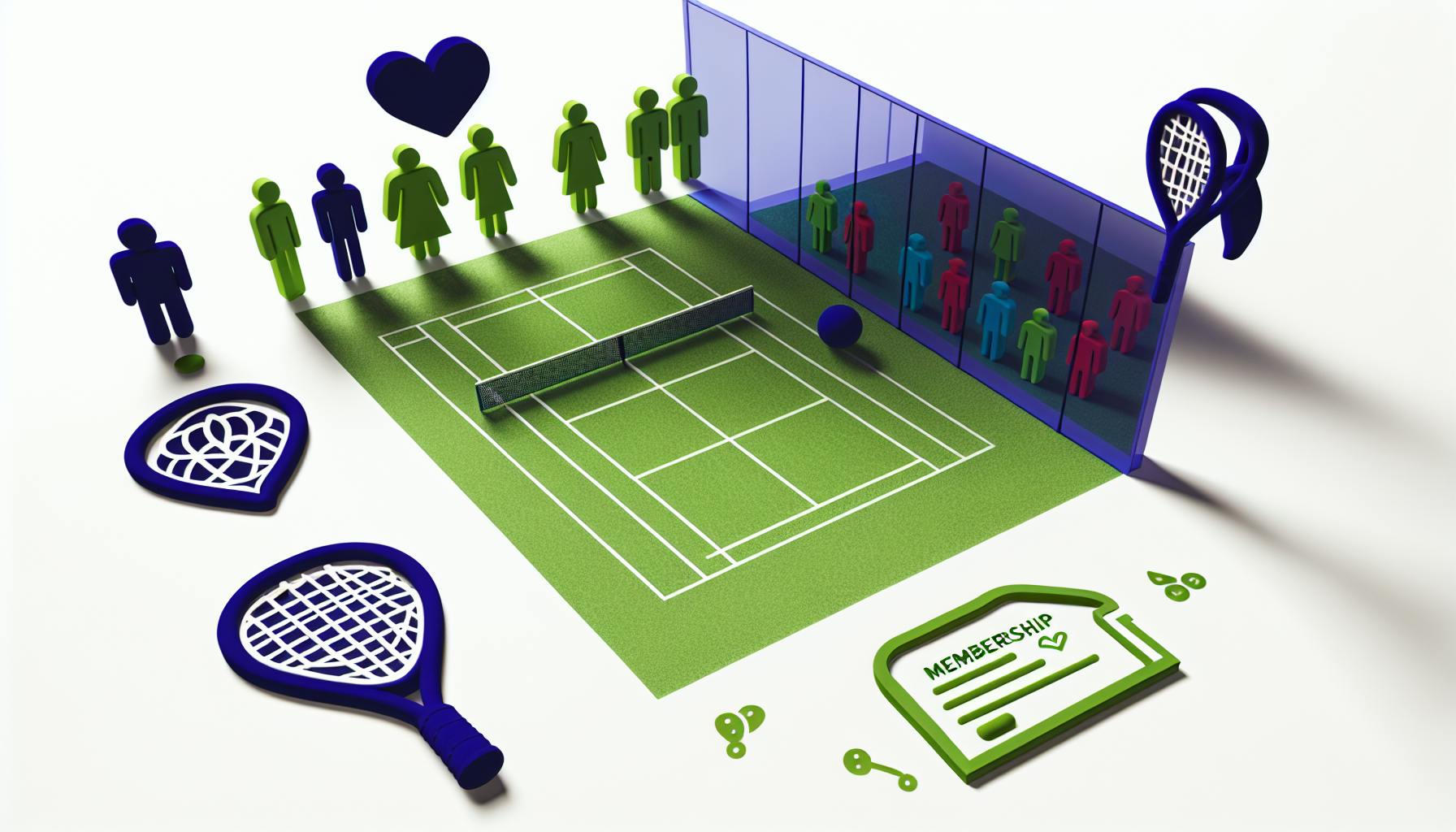Building a padel court involves selecting the right materials and designs to ensure durability, safety, and the best playing experience. Here's what you need to know in simple points:
- Court Dimensions: Official size is 20 meters long and 10 meters wide, with specific zones for service.
- Foundation and Subfloor: A strong concrete base, with considerations for outdoor weather.
- Walls and Fences: Options include brick, concrete, tempered glass, and acrylic, each affecting the game's speed and safety.
- Court Surface: Choices like concrete, wood, and artificial turf impact the game's pace and players' comfort.
- Lighting: Adequate lighting (at least 500 lux) is crucial for visibility and safety, with higher intensity required for competitive play.
- Accessories: Nets, posts, entrance gates, and other features enhance gameplay and safety.
- Future Planning: Consider potential expansion in your initial design to accommodate more courts later.
This checklist covers the essentials for building a padel court, focusing on materials and design choices that affect gameplay, safety, and durability.
Length and Width
Here are the must-have measurements for the court:
- Length: 20 meters (65 feet 7 inches)
- Width: 10 meters (32 feet 10 inches)
You can be a tiny bit off (up to 0.5%) in these sizes because of small hiccups when building.
Lines and Zones
The court is divided up like this:
- Service lines: These cut each half of the court into two equal parts, making four squares that are each 10 x 10 meters (32 feet 10 inches x 32 feet 10 inches).
- Central service line: This line splits those squares down the middle to make service boxes on each side that are 10 x 5 meters (32 feet 10 inches x 16 feet 5 inches).
These lines show where players serve and define the playing area. They should stand out and be made of stuff like plastic tape or paint that doesn't mess with how the ball bounces.
To make sure your padel court is just right for official games, measure everything carefully. People who build padel courts know how to do this well, so they're a big help in getting everything set up correctly.
Foundation and Subfloor
A good, strong base is super important for a padel court. It keeps the court steady and stops it from cracking or shifting. For outdoor courts, you also need to think about the weather.
Concrete Foundation
For a padel court, you should use a thick concrete base, around 18-20 cm (7-8 inches). This makes the court strong and keeps it from bending or breaking:
- Stops cracks from getting bigger under pressure
- Keeps the court from moving, so the surface is even and the ball bounces the same everywhere
Adding steel bars inside the concrete makes it even stronger. It's also important to have good drainage and a barrier to keep moisture out.
Outdoor Considerations
For courts outside, you need to do a few extra things to deal with rain, snow, and changes in temperature:
- Slope surface at 1% grade - A slight slope helps water run off the court instead of pooling. This stops slippery spots and damage from too much water.
- Apply durable sealants - Putting on special coatings every 2-3 years protects the court from weather.
- Install freeze-proof plumbing - Make sure any water systems under the court can handle freezing temperatures to avoid breaks.
- Incorporate control joints - Cutting grooves in the concrete helps it handle the pressure from expanding and contracting without cracking.
Building the foundation and subfloor right means you get a smooth, lasting padel court that's fun to play on for a long time.
Walls and Fences
Wall Materials
The walls and fences are really important for a padel court. They impact how the game feels and keep everyone safe. Here's a look at the best choices:
- Brick:
- Super strong and can handle all kinds of weather
- Makes the ball bounce back the same way every time
- Costs more to put up
- Might crack if you don't take care of it
- Concrete:
- The cheapest option for walls
- Can crack if you don't use the right protective coatings
- Might get rough spots that change how the ball bounces
- Tempered or Laminated Glass:
- Gives the best and most predictable bounce back for the ball
- Costs more but lasts a long time and handles weather well
- Safe because it won't break into sharp pieces
- Needs to be set up right to avoid breaking
- Acrylic/Plexiglass:
- Light and easy to put up
- Gets scratched up more than glass
- Lets you see through it really well
- Ball bounce might not always be the same
- Can get brittle and hard to see through after a while
Think about how the ball bounces, how easy it is to see, the cost, how long it lasts, and how safe it is when picking your materials. Glass or acrylic walls that are put up by pros are usually the best for a smooth game.
Fence Specifications
The fences made of wire mesh keep the ball from flying out of the court. Here's what you need to know:
- Mesh Opening Size: Between 5 to 7.08 cm
- Proper Installation: The fence needs to be tightly fixed to a metal frame and lined up just right with the walls. If it's not straight, it can mess up how the ball bounces.
- Withstand Impacts: The fence must be tough enough to take hit after hit without getting damaged or starting to sag.
Setting up the fence the right way keeps everyone safe and makes sure the ball bounces back properly. It's a good idea to hire someone with experience in padel court construction to help with this.
Court Surface Options
Choosing the right surface for your padel court is a big deal. It affects how the game plays out, how long the court lasts, and how much fun players have. Here's a simple guide to help you decide.
| Surface Material | Description |
|---|---|
| Concrete/Cement | Tough and long-lasting, makes the ball bounce in a predictable way |
| Wood | A bit softer, gives a steady bounce |
| Artificial Turf | Good for controlling the ball's speed, easy to look after |
Color Recommendations
Go for a color that's easy on the eyes and different from the walls. Green, blue, or brown are good picks. Black works best for indoor courts.
Here's what to think about when picking your court's surface:
Even Bounce - You want the ball to bounce the same way everywhere on the court. Concrete and artificial grass are great for this.
Toughness - Choose a material that can handle a lot of games and weather changes. Concrete is super tough, but some other materials might need more care.
Game Speed - The material affects how fast the ball moves. You don't want it too fast or too slow. Artificial grass and wood are good for keeping the game fun.
Safety - Pick a surface that won't make players slip or fall easily. Some materials can get slippery, especially when wet.
Looks - A nice-looking court makes playing even better. Using different colors for the surface and walls helps players see the game area clearly. Green, blue, gray, and brown are popular choices.
Cost - Think about how much you want to spend. Concrete is cheaper but might need more work to get ready. More expensive options like artificial turf can be easier to set up.
Talk to a pro about what you want and how much you can spend to find the best surface for your padel court. They can help you make a choice that's good for your game, safe for players, and easy on your wallet.
Lighting System
Getting the lighting right on a padel court is super important. It makes sure everyone can see well and stay safe while they play, whether it's day or night. Here's what to keep in mind for lighting, whether your court is indoors or outdoors:
Light Intensity
- You'll want at least 500 lux (that's a measure of light) for casual games. It's enough light so you can see everything clearly.
- If you're hosting tournaments, aim for 800-1,000 lux. This helps players see the fast-moving ball better.
- Pick lights that are made for sports areas. They help spread the light evenly across the court, so there are no dark spots.
Glare Reduction
- Set up lights so they don't shine directly in players' eyes. This can be really distracting.
- For outdoor courts, use covers on lights to reduce glare.
- Choose wall and floor materials that don't reflect light too much and cause glare.
Flicker Control
- Use lights that don't flicker. Flickering can be annoying and distracting.
Color Rendering
- Go for lights that make colors look real (this is called high CRI). It helps players see the ball and court lines better.
Emergency Backup
- Have some backup lights ready in case the main lights go out. This way, everyone can safely leave the court.
Smart Controls
- Use tech like timers and motion sensors to save electricity. This way, lights are only on when you need them.
Hire a Professional
- It's a good idea to get help from someone who knows about sports lighting. They can make sure your lights are set up just right for your padel court.
With good lighting, your padel court will be a great place to play, any time of day. Just remember to keep the light even and not too bright or glaring.
sbb-itb-5591e69
Accessories and Additional Features
Adding some extra stuff to your padel court can make it safer and more fun to play on. Here are some things to consider adding.
Nets and Posts
The net is a big part of the game, dividing the court into two. You'll need:
- Net height: 0.88 meters in the middle and a bit taller at the ends, 0.92 meters
- Net length: Should stretch 10 meters across
- Net mesh size: The holes in the net should be 45 mm big
- Net posts: These are the poles that hold up the net. They should be round and covered with padding to prevent injuries. Make sure they're really stuck in the ground.
Choose equipment that's specifically made for padel to make sure it fits the court and is safe.
Entrance Gates
Doors that let players in and out of the court are handy. Pick doors that close by themselves and lock with a key or a magnet. Doors should open outwards and have soft edges for safety.
Windscreens
If your court is outside, think about adding clear screens on the fences. They block the wind and can make playing easier.
Court Numbers/Names
Naming your court or giving it a number is a nice touch. It helps organise games and tournaments. You can put the name on the gate or the walls.
Safety Padding
Cover any metal parts like poles and edges with thick foam padding. This helps prevent injuries if players bump into them. If the padding gets old or torn, replace it.
Ball Machines
A machine that throws balls is great for practice. The best ones can change speed and direction, and you can control them with a remote.
Scoreboards
Having a digital scoreboard lets everyone keep track of the score easily. Choose ones that are easy to read outside and don't get washed out by the sun.
With the right extra features, your padel court will be a better place to play for years. These additions improve the game and keep players safe.
Scalability and Future Growth
When you're putting together a padel court, think about whether you'll want more courts later on. Planning for the future from the start makes it easier to grow your setup later.
Here are some straightforward tips for getting your padel court ready for more action down the road:
Leave space for expansion
- Look over your land to see if there's room for an extra 1-2 full-sized courts in the future.
- Make sure you have at least 25 x 35 meters of extra space for each new court, plus room for more parking and other stuff like trees and benches.
Build strong infrastructure
- Make sure important things like water drainage, lights, and electricity are set up for more courts from the get-go.
- Use strong wires and pipes that won't need to be replaced or upgraded soon.
- Plan the base of your court to stretch beyond just the area you're using now.
Design a master plan
- Think about the whole setup you want, not just what you're building now.
- Plan where things like roads and clubhouses will go in the future.
- Get an architect to draw up plans that you can add to over time.
Construct modular buildings
- Go for buildings you can easily add onto later, like prefab (pre-built) ones.
- Consider using shipping containers for cheap, moveable storage.
- Start with simple buildings so you can adjust as your needs change.
Choose durable materials
- Even if you're just building one court for now, pick materials that are made for lots of use.
- Spending a little more now means you'll spend less on fixing and replacing stuff as you expand.
With some smart planning and design, you can start with one padel court and grow it into a big facility as more people get into the game.
Conclusion
When building a padel court that everyone will love playing on for years, picking the right stuff and getting pros to do the job is super important. You've got to think about keeping players safe, making sure the court lasts a long time, plays well, doesn't cost too much, and looks good.
Here's what to keep in mind:
- Start with a solid base, like thick concrete, especially if your court is outside. This keeps the ground from moving and cracking. Make sure water can run off and it's protected from the weather.
- Use glass or acrylic for the walls and make sure the fencing is put up tight. This makes the ball bounce back just right, making the game more fun.
- Choose a surface like artificial grass or smooth concrete that lets the ball bounce evenly. Wood can also be good for controlling the game.
- Set up lights that are bright enough (at least 500 lux) and spread light all over the court. This makes sure everyone can see well and play safely.
- Add things like gates, screens, padding, and ball machines to make the court better and safer.
- If you think you might want to add more courts later, plan for that now. Leave some space, build things strong, and use materials that will last.
By remembering these tips and working with people who know how to build padel courts, you can make a great place to play that lasts a long time. It's all about planning carefully and choosing the right materials.
Related Questions
What is the material of paddle court?
Padel courts can be made from a few different materials:
- Concrete or cement: This is really tough and makes the ball bounce in a predictable way.
- Artificial turf: This is softer underfoot, which is easier on your knees and ankles, and it helps control the ball better.
- Acrylic: This is strong but can get scratched, which might affect how the ball bounces.
- Wood: This gives a softer bounce and feels nicer to play on but needs more looking after.
Concrete and artificial grass are usually the top picks for serious or tournament play.
How to build a padel court?
To put together a padel court, follow these steps:
- Make sure the ground is ready, with a way for water to drain and a bit of a slope.
- Put down a concrete edge around the court.
- Set up the walls or fences (using glass or acrylic panels in metal frames).
- Lay down the court surface (like concrete or artificial turf).
- Install lights, the net, entrance gates, and any safety padding.
It's a smart move to get a company that knows how to build padel courts to do the work. They'll make sure it meets the right sizes and is safe to play on.
How much does it cost to have a padel court?
Building a padel court usually costs between $24,000 and $65,000. The price varies based on:
- The size of the court
- Using high-quality materials versus more basic ones
- Building it indoors versus outdoors
- Hiring professionals to do the installation
Choosing top-notch materials like glass walls and special lights can make it more expensive. But getting experts to build it means it'll be set up right.
What is the foundation of a padel court?
The foundation is super important for a padel court. It's usually made of concrete and does a few key things:
- Keeps the court level for playing
- Holds the walls and fencing in place
- Makes sure the net and other parts are securely attached
- Deals with water through a slight slope
- Stays in good shape for many years with the right care
A strong concrete base with reinforcement, proper joints, and good drainage makes a solid foundation that lasts.


